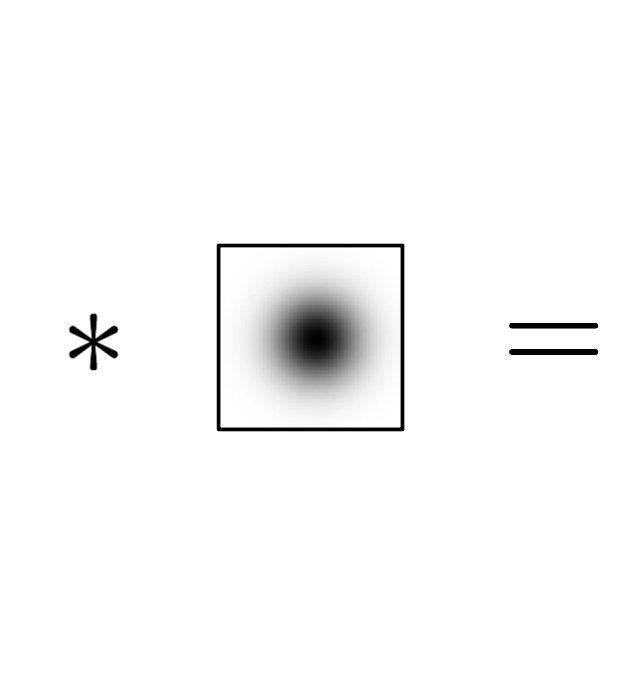Title
Recall: Discrete Differential Geometry
Uniform Laplace
- Uniform Laplace-Beltrami discretization \[ \laplace f\of{v_i} \;:=\; \frac{1}{\abs{\set{N}_1\of{v_i}}} \sum_{v_j \in \set{N}_1\of{v_i}} \left( f\of{v_j} - f\of{v_i} \right) \]
- Properties
- depends only on connectivity
- does not take into account geometry at all
- not accurate for irregular triangulations

Discrete Laplace-Beltrami
- Cotangent Laplace-Beltrami discretization \[ \laplace_{\set{S}} f\of{v_i} \;:=\; \frac{1}{2A\of{v_i}} \sum_{v_j \in \set{N}_1\of{v_i}} \left( \cot \alpha_{ij} + \cot \beta_{ij} \right) \left( f\of{v_j} - f\of{v_i} \right)\]
- Properties
- depends on connectivity and geometry
- more accurate than uniform discretization
- weights can become negative
- most frequently used discretization
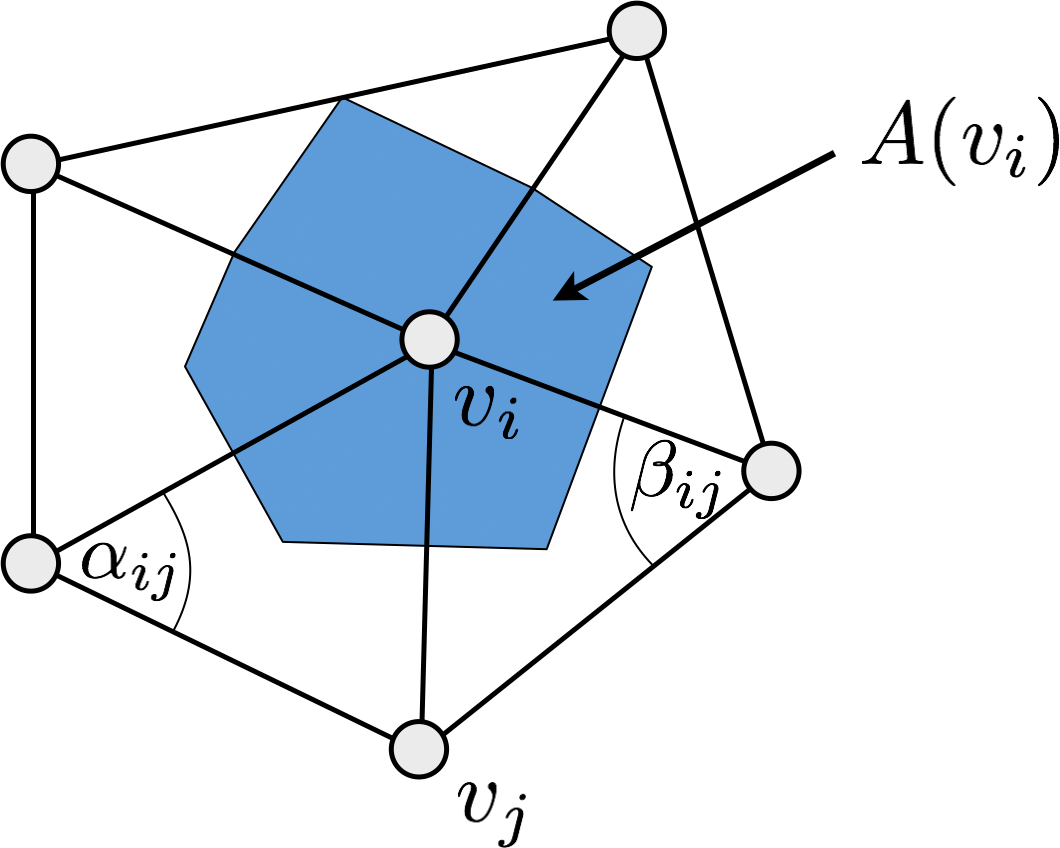
Discrete Curvatures
- Mean curvature (absolute value) \[ H(v_i) = \frac{1}{2} \norm{ \laplace_\set{S} \vec{x}_i}\]
- Gaussian curvature \[ K(v_i) = (2 \pi - \sum_j \theta_{j}) \,/\, A(v_i) \]
- Principal curvatures \[ \begin{eqnarray} \kappa_1(v_i) &=& H(v_i) + \sqrt {H(v_i)^2 - K(v_i)} \\ \kappa_2(v_i) &=& H(v_i) - \sqrt {H(v_i)^2 - K(v_i)} \end{eqnarray} \]
Today: Mesh Smoothing
Motivation
- Filter out high-frequency noise
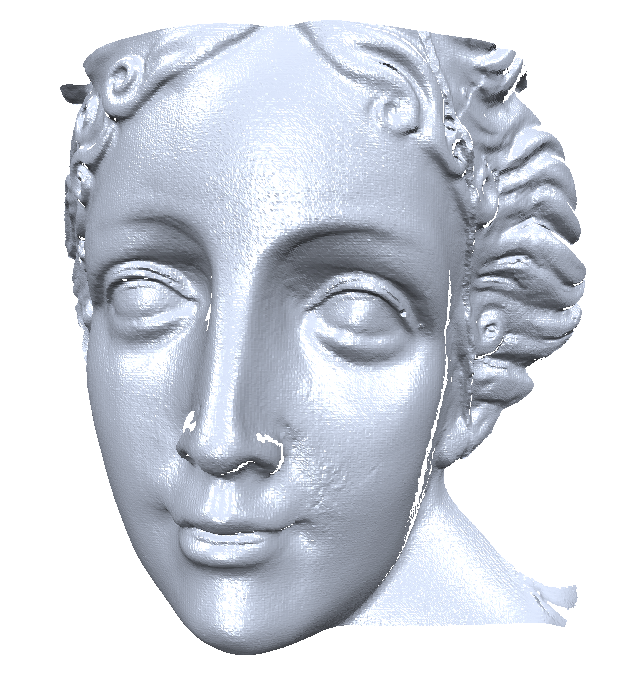


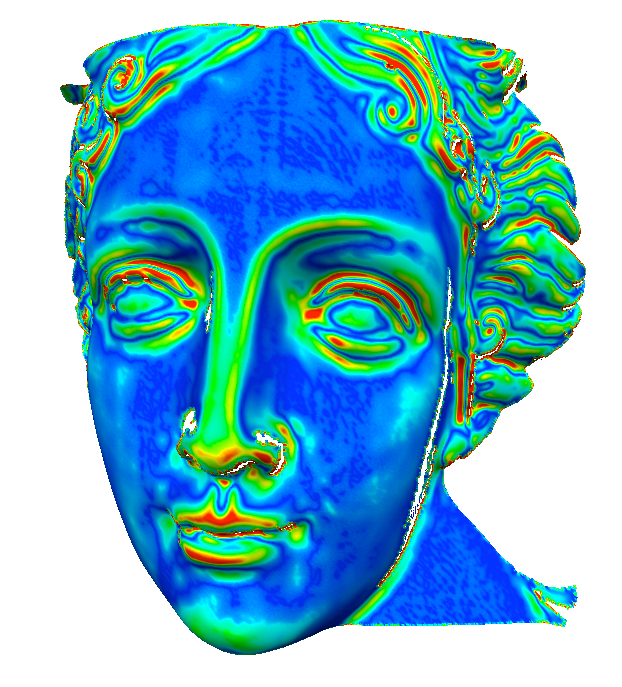
Motivation
- Filter out high-frequency noise

Motivation
- Advanced filtering
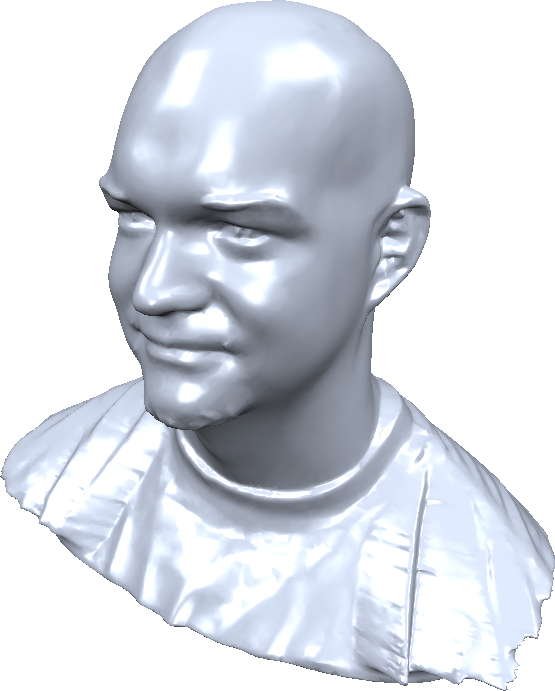
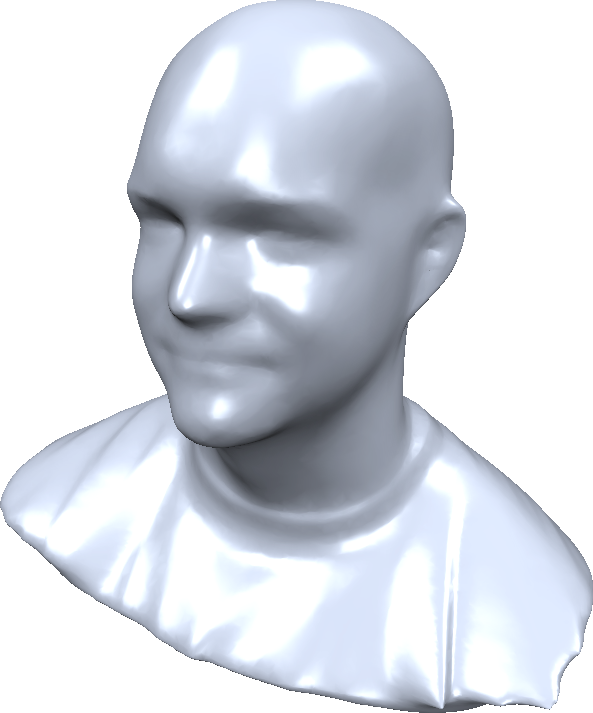
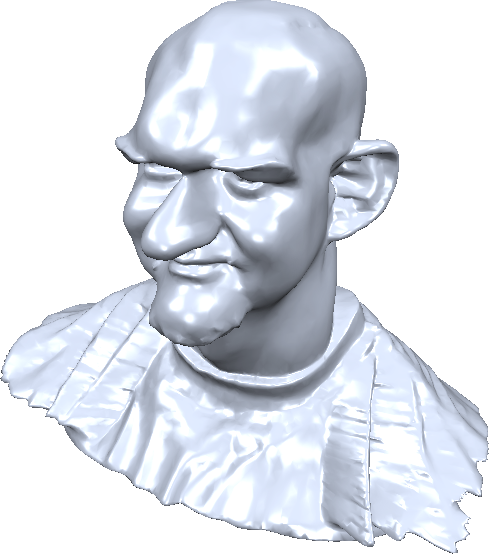
Kim, Rosignac: Geofilter: Geometric Selection of Mesh Filter Parameters, Eurographics 2005
Outline
- Spectral Analysis
- Diffusion Equation
- Numerical Solutions
Spectral Analysis
Fourier Transform
- Represent a function as a weighted sum of sine and cosine functions

(1768-1830)

\[ f\of{x} \;=\; a_0 + a_1 \cos\of{x} + a_2 \cos\of{3x} + a_3 \cos\of{5x} + a_4 \cos\of{7x} + \dots \]
Fourier Transform
\[F(\omega) = \int_{-\infty}^{\infty} f(x) \, \func{e}^{-2\pi\func{i}\omega x} \func{d}x\]

\[f(x) = \int_{-\infty}^{\infty} F(\omega) \, \func{e}^{2\pi\func{i}\omega x} \;\func{d}\omega\]
Wikipedia: Fourier Transform and \(L^2\) Inner Product
Convolution
Smooth signal by convolution with a kernel function \[ h(x) \;=\; f * g \;:=\; \int f(y) \cdot g(x-y) \,\func{d}y \]
Example: Gaussian blurring
![lenna.png]()
![lenna_equation.png]()
![lenna_smooth.png]()
Convolution
Smooth signal by convolution with a kernel function \[ h(x) \;=\; f * g \;:=\; \int f(y) \cdot g(x-y) \,\func{d}y \]
Convolution in spatial domain ⇔ Multiplication in frequency domain \[ H\of{\omega} \;=\; F\of{\omega} \cdot G\of{\omega} \]
Filtering with Fourier Transform
- Spatial domain \(f(x) \rightarrow\) frequency domain \(F(\omega)\)
\[ F(\omega) = \int_{-\infty}^{\infty} f(x) \, \func{e}^{-2\pi \func{i}\omega x} dx\] - Multiply by low-pass filter \(G(\omega)\)
\[ \tilde{F}(\omega) = F(\omega) G(\omega)\] - Frequency domain \(\tilde{F}(\omega) \rightarrow\) spatial domain \(\tilde{f}(x)\)
\[ \tilde{f}(x) = \int_{-\infty}^{\infty} \tilde{F}(\omega) \, \func{e}^{2\pi \func{i}\omega x} dx\]
Filtering with Fourier Transform
Filtering with Fourier Transform

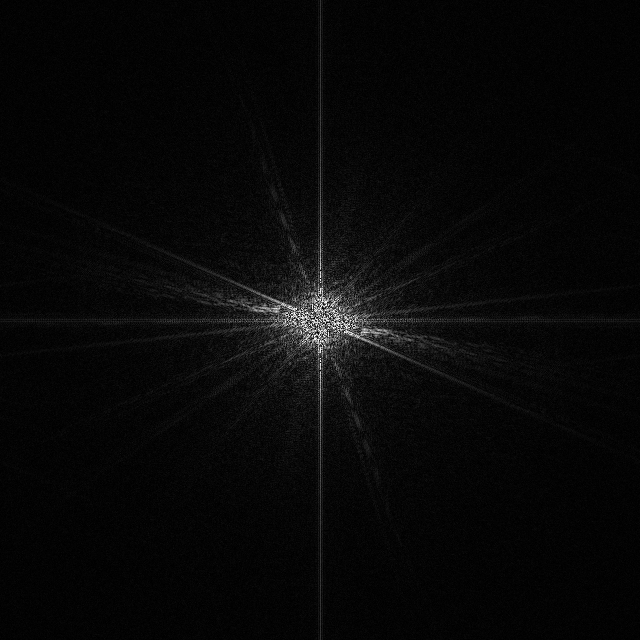


Spectral Analysis for Meshes
- Fourier transform requires functional representation
- How to generalize to meshes?
- Observation: Complex waves are eigenfunctions of Laplacian \[\Delta e^{2 \pi \func{i} \omega x} = \frac{\func{d}^2}{\func{d}x^2} \func{e}^{2 \pi \func{i} \omega x} = -(2 \pi \omega)^2 \func{e}^{2 \pi \func{i} \omega x}\]
- Idea: Use eigenfunctions of discrete Laplace-Beltrami as spectral basis
Discrete Laplace-Beltrami
- Function values sampled at the \(n\) mesh vertices \[\vec{f} = [f(v_1), f(v_2), \ldots, f(v_n)]\T \in \R^n\]
- Discrete Laplace-Beltrami (per vertex) \[ \laplace f\of{v_i} = \frac{1}{2A_i} \sum_{v_j \in \set{N}_1\of{v_i}} \left( \func{cot} \alpha_{ij} + \func{cot} \beta_{ij} \right) \left( f \of{v_j} - f \of{v_i} \right)\]

Discrete Laplace-Beltrami
- Discrete Laplace operator is sparse matrix \(\mat{L} = \mat{DM} \in \R^{n \times n}\)
\[ \matrix{\vdots \\ \laplace_\set{S} f\of{v_i} \\ \vdots} \;=\; \mat{L} \cdot \matrix{\vdots \\ f \of{v_i} \\ \vdots} \]
Discrete Laplace-Beltrami
- Discrete Laplace operator is sparse matrix \(\mat{L} = \mat{DM} \in \R^{n \times n}\)
\[ \begin{align} \mat{M}_{ij} \;&=\; \begin{cases} \func{cot}\alpha_{ij} + \func{cot}\beta_{ij}, & i \ne j \,,\; j \in \set{N}_1\of{v_i} \\ - \sum_{v_j \in \set{N}_1 \of{v_i}}\of{ \func{cot}\alpha_{ij} + \func{cot}\beta_{ij} } & i=j \\ 0 & \text{otherwise} \end{cases} \\[2mm] \mat{D} \;&=\; \func{diag}\of{ \dots, \frac{1}{2A_i}, \dots} \end{align} \]
Spectral Mesh Analysis
- Discrete Laplace operator is sparse matrix \(\mat{L} = \mat{DM} \in \R^{n \times n}\)
- Eigenvectors are “natural vibrations”
- Eigenvalues are “natural frequencies”

Levy, Zhang: Spectral Mesh Processing, SIGGRAPH Courses 2010
Spectral Mesh Analysis
- Setup Laplace-Beltrami matrix \(\vec{L}\)
- Compute \(k\) smallest eigenvectors \(\{\vec{e}_1, \ldots, \vec{e}_k\}\)
- Reconstruct mesh from those (component-wise) \[ \begin{align} \vec{x} &:= \left[ x_1, \dots, x_n \right] & \vec{y} &:= \left[ y_1, \dots, y_n \right] & \vec{z} &:= \left[ z_1, \dots, z_n \right] \\ \vec{x} &\leftarrow \sum_{i=1}^k \, \left( \trans{\vec{x}} \vec{e}_i \right) \vec{e}_i & \vec{y} &\leftarrow \sum_{i=1}^k \, \left( \trans{\vec{y}} \vec{e}_i \right) \vec{e}_i & \vec{z} &\leftarrow \sum_{i=1}^k \, \left( \trans{\vec{z}} \vec{e}_i \right) \vec{e}_i \end{align} \]
Spectral Mesh Analysis
- Setup Laplace-Beltrami matrix \(\vec{L}\)
- Compute \(k\) smallest eigenvectors \(\{\vec{e}_1, \ldots, \vec{e}_k\}\)
- Reconstruct mesh from those (component-wise)
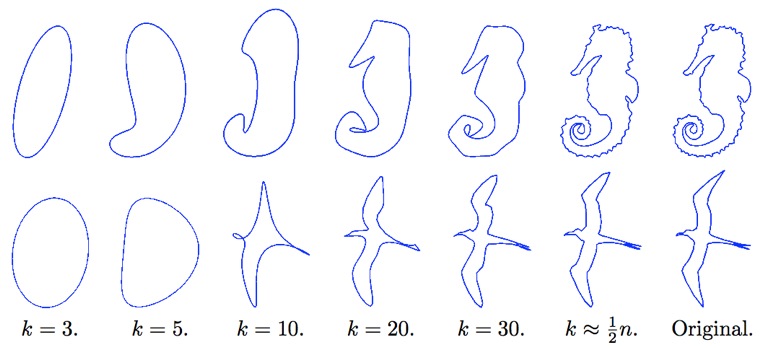
Levy, Zhang: Spectral Mesh Processing, SIGGRAPH Courses 2010
Spectral Mesh Analysis
- Setup Laplace-Beltrami matrix \(\vec{L}\)
- Compute \(k\) smallest eigenvectors \(\{\vec{e}_1, \ldots, \vec{e}_k\}\) Too complex for large meshes 😢
- Reconstruct mesh from those (component-wise)
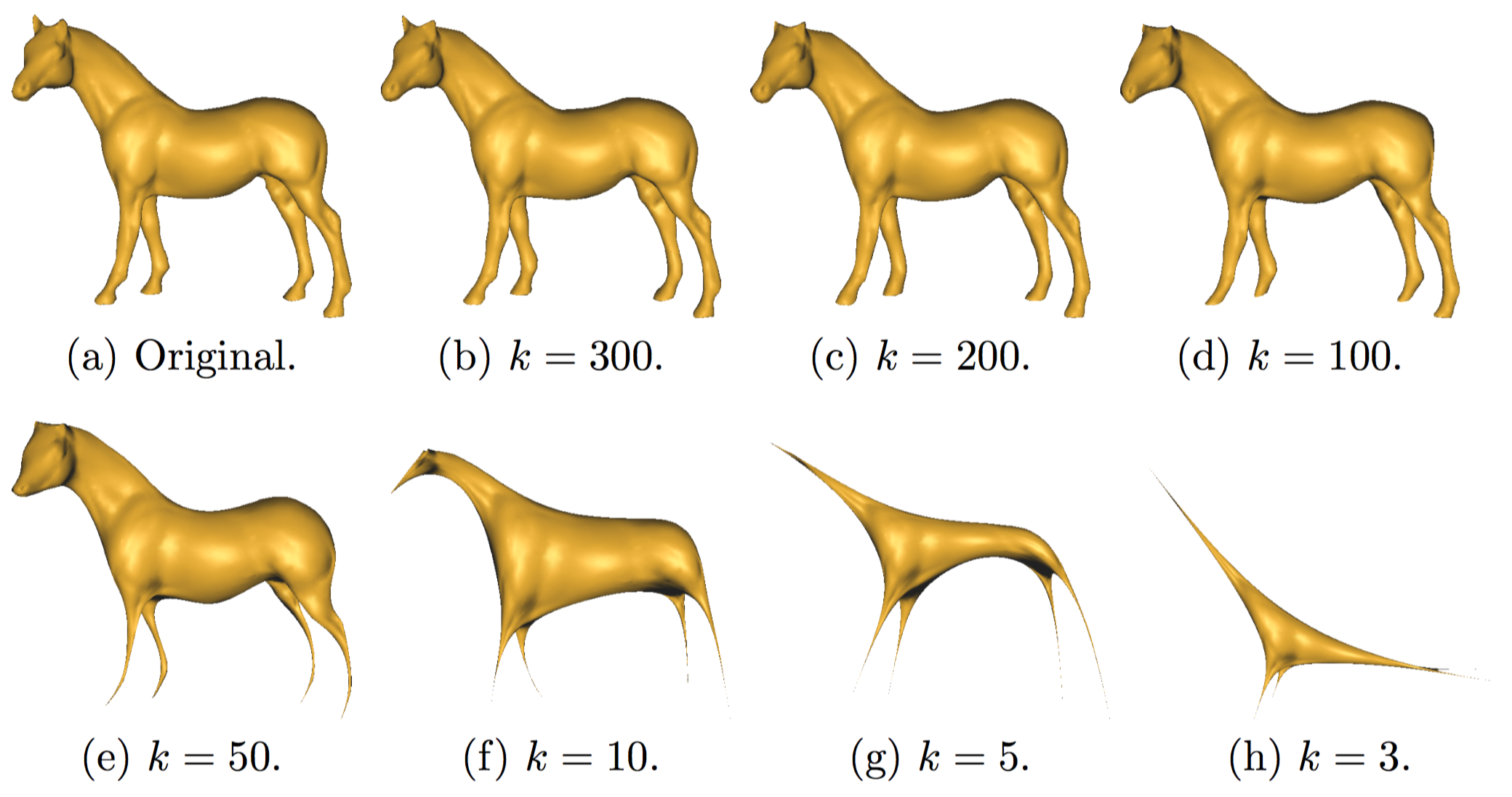
Levy, Zhang: Spectral Mesh Processing, SIGGRAPH Courses 2010
Diffusion Flow
Diffusion Flow
- Diffusion equation is frequently used to smooth signals \[\frac{\partial f}{\partial t} = \lambda \Delta f\]
- \(\lambda\) is the diffusion constant
- \(\Delta\) is the Laplace operator
- Solve numerically
- Discretize function in space & time
- Discretize time derivative
- Discretize spatial derivatives

Discretize PDE on Regular Grid
- Sample function \(f(x,y,t)\) on a regular grid with spacing \(h\) and time-step \(\delta_t\) \[f[i,j,t] \;=\; f\left(i \cdot h, j \cdot h, t \cdot \delta t \right) \]
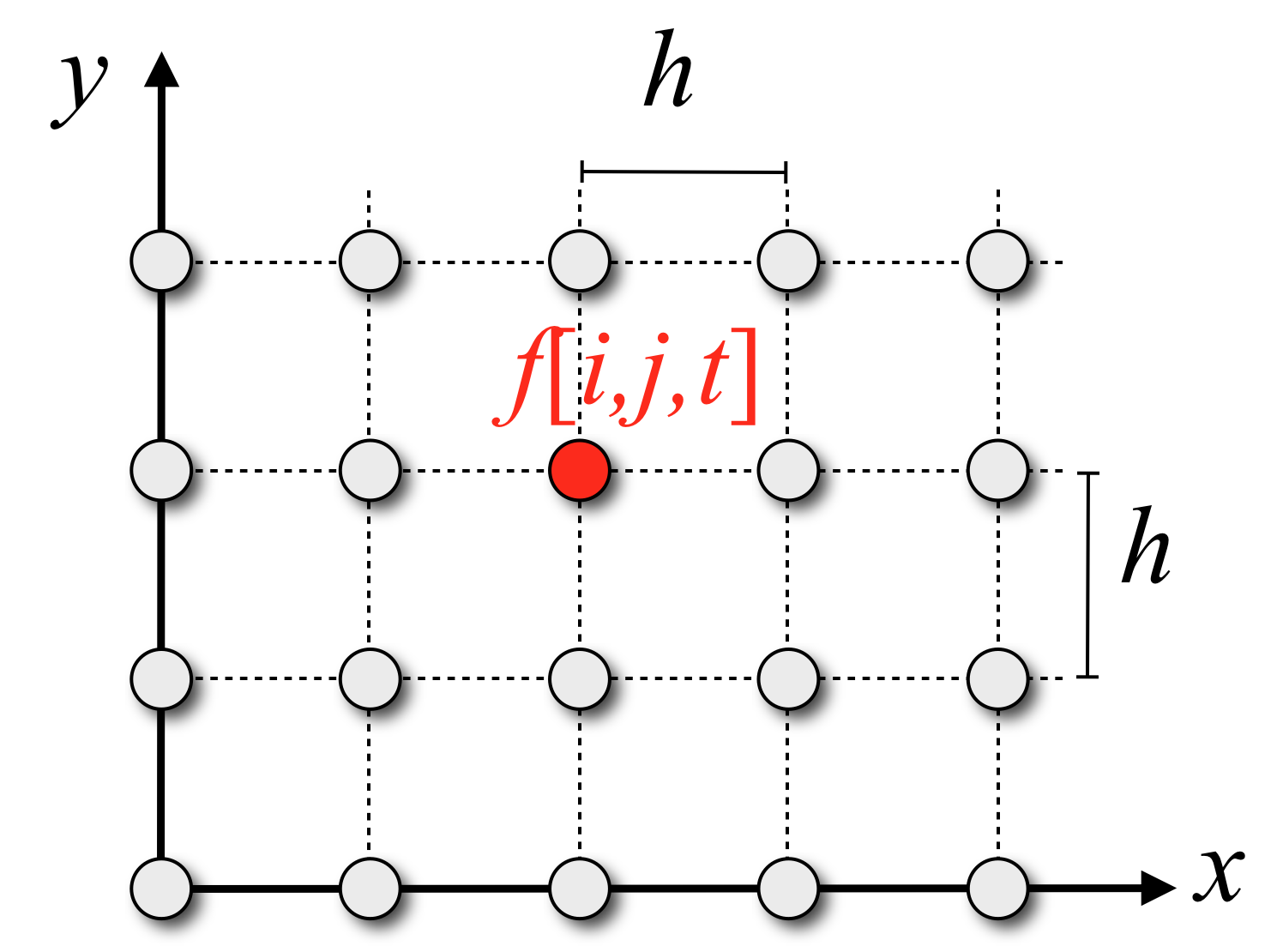
Discretize PDE on Regular Grid
- Sample function \(f(x,y,t)\) on a regular grid with spacing \(h\) and time-step \(\delta_t\) \[f[i,j,t] \;=\; f\left(i \cdot h, j \cdot h, t \cdot \delta t \right) \]
- Approximation of temporal derivative \[ f_{,t}[i,j,t] \;\approx\; \frac{f[i,j,t+1] - f[i,j,t]}{\delta t}\]
- Approximation of Laplacian \[ \laplace f[i,j,t] \;=\; \frac{f[i+1,j,t] + f[i-1,j,t] + f[i,j+1,t] + f[i,j-1,t] - 4f[i,j,t] }{h^2} \]
Diffusion Flow in 2D
- Continuous PDE \[f_{,t} \;=\; \lambda \left( f_{,xx} + f_{,yy} \right)\]
- Finite difference discretization \[\frac{f[i,j,t+1] - f[i,j,t]}{\delta t} \;=\; \lambda \frac{f[i+1,j,t] + f[i-1,j,t] + f[i,j+1,t] + f[i,j-1,t] - 4f[i,j,t] }{h^2}\]
- Leads to explict Euler time-integration \[f[i,j,t+1] \;=\;
f[i,j,t] + \delta t \lambda \frac{f[i+1,j,t] + f[i-1,j,t] + f[i,j+1,t] + f[i,j-1,t] - 4f[i,j,t] }{h^2}\]
- \(\delta t \lambda\) has to be small for explicit Euler (<1 in this case)!
Diffusion in 2D
Diffusion Flow on Meshes
- Continuous PDE: \(\frac{\partial \vec{x}}{\partial t} \;=\; \lambda \Delta \vec{x}\)
- Discretization: \(\vec{x}_i \leftarrow \vec{x}_i + \delta t \, \lambda \Delta \vec{x}_i\)

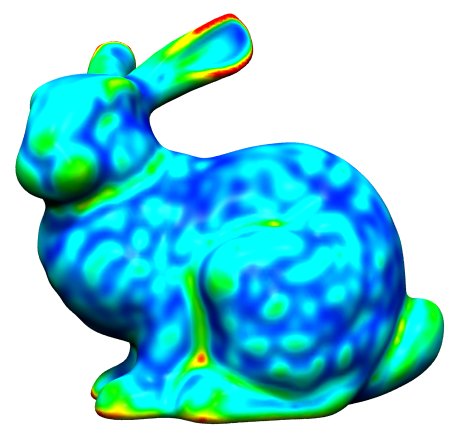

Diffusion Flow on Meshes
- Problem: Time step needs to be very small to give stable results when using cotan Laplacian with area normalization
- Better results with normalized weights (and ignoring the area term) \[\laplace \vec{x}_i \;=\;
\frac{1}{\sum_{v_j \in \set{N}_1\of{v_i}} w_{ij}}
\sum_{v_j \in \set{N}_1\of{v_i}} w_{ij} \left( \vec{x}_j - \vec{x}_i \right) \]
- Uniform weights \(w_{ij} = 1\)
- Cotangent weights \(w_{ij} = \cot\alpha_{ij} + \cot\beta_{ij}\)
Uniform Laplace Discretization
- Smoothes geometry and triangulation
- Can be non-zero even for planar triangulations
- Vertex drift can lead to distortions
- Might be desired for mesh regularization
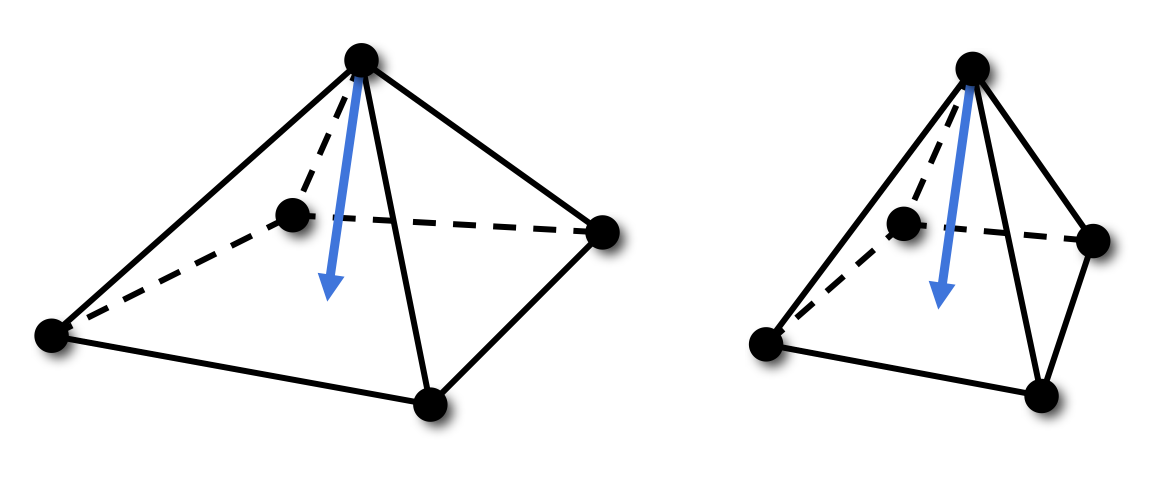
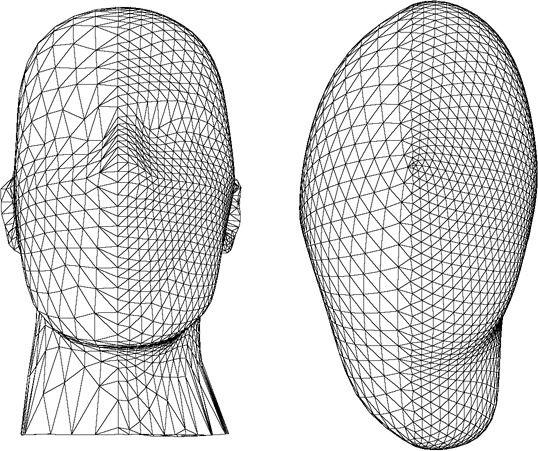
Uniform vs Cotan Discretization
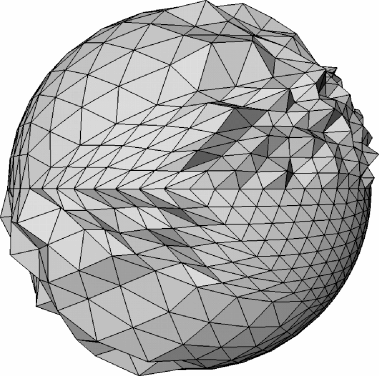

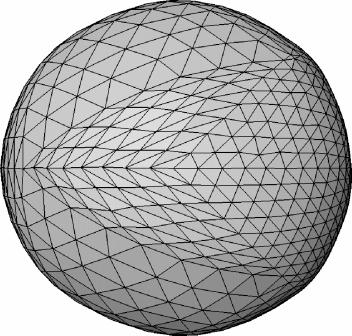
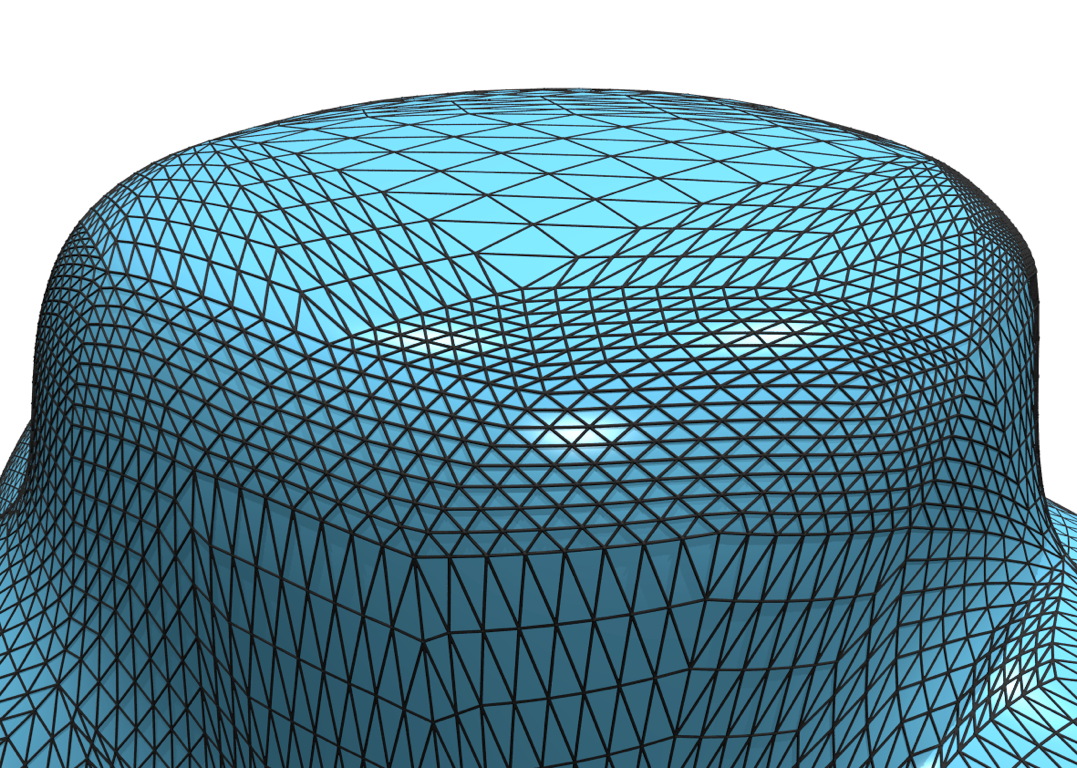
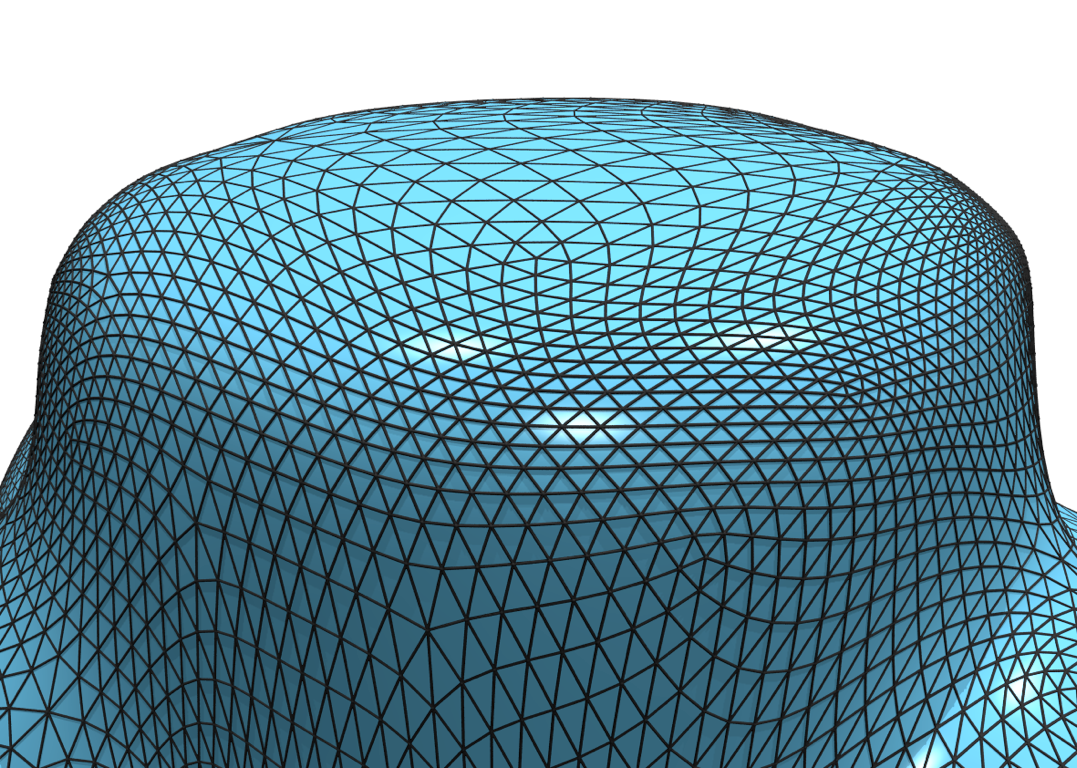
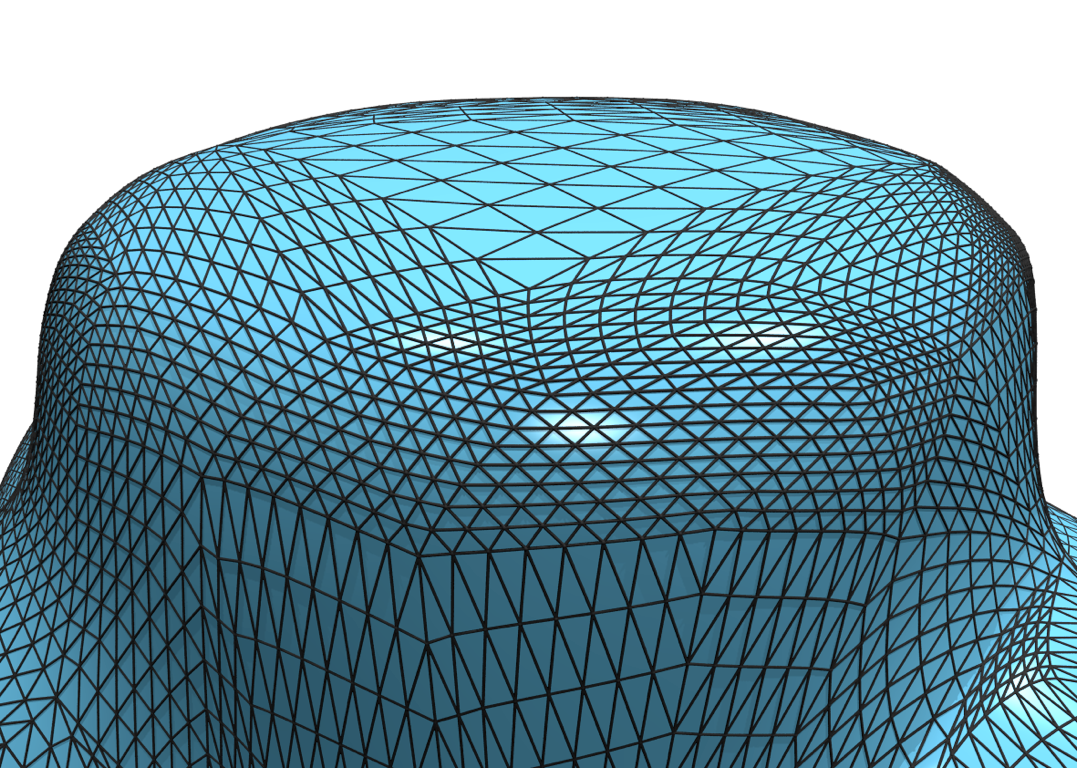
Numerical Solutions
Numerical Integration
- Let’s write the position update in matrix notation
- Write all points \(\vec{x}_i^{(t)}\) in a large vector/matrix: \[\vec{X}^{(t)} = \trans{\left( \vec{x}_1^{(t)}, \ldots, \vec{x}_n^{(t)} \right)} \in \R^{n\times 3}\]
- Matrix version of explicit integration (requires small \(\delta t \lambda\)) \[\vec{X}^{(t+1)} = (\vec{I} + \delta t \, \lambda \vec{L}) \, \vec{X}^{(t)}\]
- Matrix version of implicit integration (works for any \(\delta t \lambda\)) \[(\vec{I} - \delta t \, \lambda \vec{L}) \, \vec{X}^{(t+1)} = \vec{X}^{(t)}\]
How to solve the linear system?
- Solve linear system in each iteration \[(\vec{I} - \delta t \, \lambda \vec{L}) \vec{X}^{(t+1)} = \vec{X}^{(t)}\]
- Matrix \(\vec{L} = \vec{DM}\) is built from Laplace weights \[\mat{M}_{ij} \;=\; \begin{cases} \func{cot}\alpha_{ij} + \func{cot}\beta_{ij}, & i \ne j \,,\; j \in \set{N}_1\of{v_i} \\ - \sum_{v_j \in \set{N}_1 \of{v_i}}\of{ \func{cot}\alpha_{ij} + \func{cot}\beta_{ij} } & i=j \\ 0 & \text{otherwise} \end{cases} \]
\[\mat{D} = \func{diag}\of{ \dots, \frac{1}{2A_i}, \dots}\]

How to solve the linear system?
- Solve linear system in each iteration \[(\vec{I} - \delta t \, \lambda \vec{L}) \vec{X}^{(t+1)} = \vec{X}^{(t)}\]
- Which solvers do you know?
- Gaussian elimination? 💣
- LU factorization? 💣
- Analyze the properties of your system matrix!
- very sparse (about 7 non-zeros per row) 😄
- but not symmetric 😢
How to solve the linear system?
- Matrix \(\vec{L} = \vec{DM}\) is not symmetric because of \(\vec{D}\).
Symmetrize it by multiplying with \(\vec{D}^{-1}\) from the left \[(\vec{D}^{-1} - \delta t \, \lambda \vec{M}) \vec{X}^{(t+1)} = \vec{D}^{-1} \vec{X}^{(t)}\] - Now the linear system is
- sparse 😄
- symmetric 😄
- positive definite 😄
- We can use much more efficient solvers!
- conjugate gradients 😘
- sparse Cholesky factorization 😍
Try it yourself!
Literature
- Botsch et al., Polygon Mesh Processing, AK Peters, 2010
- Chapter 4

- Taubin, A Signal Processing Approach to Fair Surface Design, SIGGRAPH 1995
- Desbrun, Meyer, Schröder, Barr, Implicit Fairing of Irregular Meshes using Diffusion and Curvature Flow, SIGGRAPH 1999

